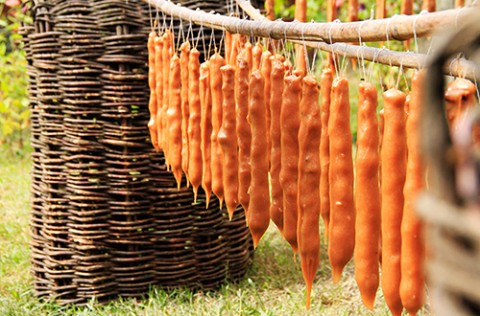These are Georgian churchkhelas, a kind of national candy made from a string of walnut halves dipped in grape juice thickened with flour (Tatara or Phelamushi), and dried in the sun. There are essentially 2-3 kinds of Churchkhela. Somebody may be better in making them, somebody worse, but all in all, it is the same stuff sold all over Georgia.
These are the Turkish analogs. If you have been to Istanbul’s Spice Bazaar, you will know firsthand that there is a much greater variety – both in terms of nuts and the fruit one uses to make the “sauce”. Also the shapes are much more diverse and imaginative.
A sweets market in Istanbul (source: Creative commons)
Churchkela is just one example of how little “product innovation” there is in Georgia. One will most likely find a very similar pattern in many other spheres of economic activity in Georgia. Walk into any Georgian restaurant, and you will be offered the same, rather limited menu of (delicious) traditional dishes: five types of khinkali, four types of khachapuri and pkhali, three types of mtswadi, etc. People know how to make products their grandparents used to make. They may try to improve the production process, but would not move very far outside the traditional domain. In fact, the growth diagnostics study the ISET Policy Institute conducted back in 2012, identified a lack of product innovation as a symptom of Georgia’s slow economic development.
The Georgians’ unwillingness or inability to think out of the traditional box is rather puzzling. Georgians are certainly not lacking in the creativity department. Discipline is surely a problem, but creativity is not. Georgian artists, sculptors and film directors, to take one example, have been renowned for their highly original style back in the USSR days. So why is it that we don’t see many people in Georgia venturing out of the traditional?
Is it that a typical Georgian has no way of knowing what kind of things may exist and, more importantly, may sell? Are we not “plugged into” the global knowledge exchange (be it internet, international TV and newspapers). But Turkey is next door, what holds somebody back from producing a different kind of churchkhela?
INNOVATION IN THE SERVICE OF RURAL DEVELOPMENT: THE JAPANESE PERSPECTIVE
Selling traditional agricultural products and handcrafts along Georgia’s roads is a major source of income for many Georgian households. Over time some village communities have become specialized in certain products. Examples are Shrosha’s clay, Khashuri’s hammocks, Manavi’s churchkhela and tkhlapi (fruit leather), Surami’s nazuki (sweet bread), etc. However, even these “specialized” villages are doing relatively little to cultivate their local brands and innovate.
The lack of dynamism characterizing Georgia’s rural entrepreneurship is at stark contrast with what one observes in Japan, whose culture and traditions are as strong as ours. In Japan, villagers also often sell their products along the highways, yet they way they do is very different. While building new roads, Japan has invested in the creation of special roadside stations called "Michi-no-Eki”. There are close to 1,000 of them spread all over Japan, catering to more than 500 million people a year. Rather than selling identical products (BigMacs or Wendy’s), as is the case with rest stations in the US or Europe, Michi-no-Eki emphasize innovation and uniqueness: local tourist information, local culture and entertainment, locally produced and locally branded food, arts and crafts. For instance, a Michi-no-Eki may specialize in apples, yet instead of just selling whole apples it would venture into a whole range of derivatives such as jams, apple chips, apple pies, apple-shaped memorabilia, etc.
The concept of Michi-no-Eki is very well described on Trends in Japan website. “As of April 2013 there are 1004 such facilities, most of which are located in scenic mountainous regions, or along the coast. Using a mechanism whereby the local government constructs the building and private organizations manage the facility, the content of the services is left to local creativity and ingenuity. Consequently, the rest areas stand out as unique operations. Some use museums as an attraction to introduce the culture and nature of the region. Others develop a resort around a hotel.”
“Many Michi-no-Eki are turning into tourist hubs, with hot springs and play facilities, workshop practice sessions, and museums etc., and there is an increase in the number of visitors taking a drive just to visit these rest station”.
In some cases even the actual buildings themselves have become attractions. “Oguni-Yu Station lies along National Route No. 387 in Oguni-machi, Kumamoto Prefecture and is a unique conical building whose framework is made of locally produced cedar wood. The building's entire surface is covered with glass, which reflects views of the surrounding scenery and it looks just like a spaceship in a SF movie. In addition, there are many other examples of individual designs that interweave the character of the local region, such as facilities that look like samurai houses from the outside; facilities in the shape of a pottery vessel; facilities with a giant water wheel as a landmark; and so on.”
Georgia and Japan may be worlds apart, but there is nothing wrong in learning from the Japanese experience how to think out of the traditional box and harness local skills and traditions to rural development objectives. With a little nudge from Georgian government, local authorities and donors, including the Japanese International Cooperation Agency (JICA).

















Comments
https://www.tenthousandvillages.com/ This is a chain of stores in the U.S. that sell all kind of hand-crafted items. E.g. coasters made out of newspapers (http://www.tenthousandvillages.com/recycled-paper-coasters) or boxes made out of computer microcircuits.
What you leave out of consideration is perhaps a demand side. In countries with high consumer confidence and strong demand (US, Japan) innovation usually follows.
Turkey's economy made a sharp jump after the 2001 crisis. Are you implying that Turkish sujuks did not exist until then?